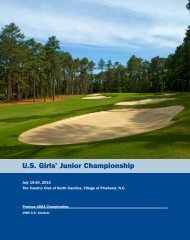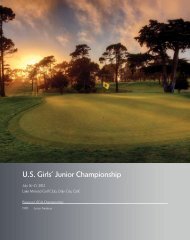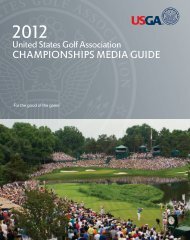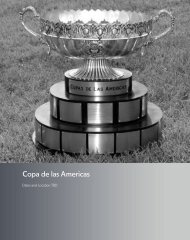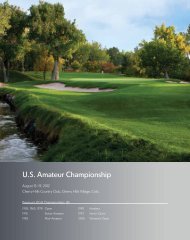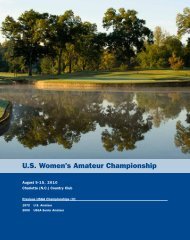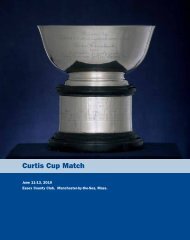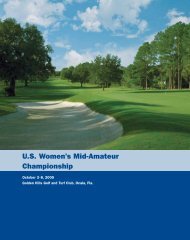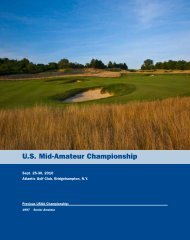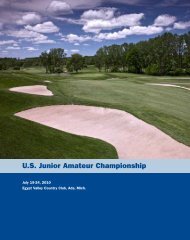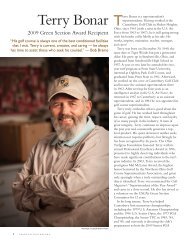Sr. <strong>Amateur</strong> 10 <strong>USGA</strong> <strong>Senior</strong> <strong>Amateur</strong> 141 Paul Simson, Raleigh, N.C., 71-70 143 George Marucci Jr., Villanova, Pa., 73-70; Michael Kelly, Odenton, Md., 74-69; Mitch Voges, Simi Valley, Calif., 72-71 144 David Pocknall, Katy, Texas, 75-69; Eddie Lyons, Shreveport, La., 71-73; Howie Knodt, Chula Vista, Calif., 68-76; Kemp Richardson, Laguna Niguel, Calif., 72-72; Ronald Vannelli, Edison, N.J., 70-74; Tom Doughtie, Amarillo, Texas, 69-75 145 John Grace, Fort Worth, Texas, 74-71 146 David Strawn, Charlotte, N.C., 72-74; Richard Umani, West Chester, Pa., 71-75; Sam Farlow, Birmingham, Ala., 73-73; Vinny Giles, Richmond, Va., 73-73 147 Dave Denezza, Greensburg, Pa., 69-78; Johnny Stevens, Wichita, Kan., 74-73; Ralph Cotton, Colleyville, Texas, 75-72 148 Bill Smunk, Kingstree, S.C., 76-72; Bruce Meyer, El Paso, Texas, 70-78; Don Bliss, St. Louis, Mo., 74-74; John Benson, Punxsutawney, Pa., 73-75; Larry Netherton, Highlands Ranch, Colo., 77-71; Mark Bemowski, Mukwonago, Wis., 73-75; Stanford Lee, Heber Springs, Ark., 72-76; Wayne Smith, Austin, Texas, 71-77 149 Bill Ploeger, Columbus, Ga., 72-77; Frank Abbott, Napa, Calif., 73-76; Jerry Cundari, Portland, Ore., 77-72; Joseph Keller, Osterville, Mass., 75-74; Sam Till Jr., Fort Wayne, Ind., 74-75 150 Bruce Scamehorn, Winter Haven, Fla., 71-79; Denny Alexander, Fort Worth, Texas, 74-76; Failed to Qualify 153 *Bob Hammersla, Greenville, S.C., 79-74-(4); *John Baldwin, West Palm Beach, Fla., 74-79- (4); *John Felker, Signal Mountain, Tenn., 74-79-(6); *Mike Rice, Houston, Texas, 75-78- (4); *Steven Welker, Maricopa, Ariz., 70-83-(NS) 154 Charlie Horn, Marana, Ariz., 78-76; David Watterworth, Charlotte, N.C., 80-74; Donald Blanton, Selma, Ala., 80-74; Douglas Farr, Monroe, La., 73-81; Jim Fuchs, Richmond, Ind., 75-79; Jim Hartley, Carlsbad, Calif., 78-76; Jim Knoll, Sunnyvale, Calif., 76-78; John Hebert, Scottsdale, Ariz., 79-75; Larry Barnacle, Pine Springs, Minn., 74-80; Skip Runnels, Richmond, Ind., 74-80 155 Donald Crump, Atlanta, Ga., 79-76; Jack Rector, Thousand Oaks, Calif, 77-78; Jim Whisman, Sparks, Nev., 81-74; Kelly Crone, Littleton, Colo., 80-75; Matthew Bellis, Ambler, Pa., 76-79; Mike Bell, Indianapolis, Ind., 75-80; Mike Rollyson, Boca Grande, Fla., 79-76; Rick Ten Broeck, Chicago, Ill., 79-76; Skip Tendall, North Potomac, Md., 79-76; Stu Grendahl, McFarland, Wis., 77-78; Thomas Mish, Grapevine, Texas, 81-74; William Lee, New Haven, Conn., 78-77 156 Bill Moor, Birmingham, Ala., 77-79; Cy Kilgore, Marblehead, Mass., 76-80; Dennis Vaughn, Campbellsville, Ky., 77-79; Denny Taylor, Gladstone, Ore., 75-81; Frank Brame, Alexandria, La., 76- 80; Frank Schmidt, Waterloo, Iowa, 80-76; John Whitmore, Alexandria, Va., 80-76; Paul Nunez Jr., Wilbraham, Mass., 78-78; Scott Holloway, Eagle, Idaho, 81-75 157 Dann Merrell, West Palm Beach, Fla., 76-81; David McCook, Hastings, Minn., 77-80; Rick Westwood, Wellington, Fla., 83-74; Stan Fischer, Richmond, Va., 76-81; Taylor Metcalfe, Glendale, Ohio, 78-79; Thomas Lyons, Pleasanton, Calif., 79-78; William Garahan, Rock Hill, S.C., 83-74 158 Bob Martin, Phoenix, Ariz., 78-80; David Hambly, Bluffton, S.C., 84-74; John Fife, Albuquerque, N.M., 77-81; Richard Marlowe, Youngstown, Ohio, 80-78; Ron Hunter, Jasper, Ga., 77-81; Ronnie Tumlin, St. Augustine, Fla., 79-79; Russ Berkoben, Perrysburg, Complete Stroke-Play Results Denny Alexander, who served as general chairman for the 2008 championship, advanced to the second round of match play. Greg Kendall, Sioux Falls, S.D., 73-77; John Long, Centreville, Va., 72-78; John Pallin, Kenosha, Wis., 75-75; Jonathan Verity, Beaufort, S.C., 73-77; Michael Shelton, Belton, Mo., 74-76; Paul Murphy, Arlington, Mass., 80-70; Randy Nichols, Connersville, Ind., 72-78; Stephen Bell, Denver, Colo., 75-75 151 Alistair Catto, South Hadley, Mass., 77-74; Bill Heldmar, Tulsa, Okla., 74-77; Frank Travetto, Bartlett, Ill., 75-76; George Zahringer, New York, N.Y., 77-74; Larry Daniels, Seattle, Wash., 76-75; Stewart Alexander, Gainesville, Fla., 69-82; Thomas McGraw, Montgomery, Texas, 76- 75 152 Arthur Pierse, Ireland, 75-77; Dan Bieber, Alamo, Calif., 74-78; Frank Ford III, Charleston, S.C., 77-75; Kelly Roberts, Canada, 75-77; Norman Swenson, Boynton Beach, Fla., 77-75; Randy Reznicek, Vista, Calif., 75-77; Sid Moore, Magnolia, Ark., 78-74; Thomas Bartolacci, Washington Crossing, Pa., 73-79; Thomas Bohardt, Cleveland, Ohio, 76-76; Timothy Pope, Spartanburg, S.C., 79-73 153 *B. Shawn McLoughlin, Newtown, Conn., 78-75-(3); *Carey Watson, Coral Springs, Fla., 77-76-(2); *Edward Patridge, Birmingham, Ala., 76-77-(2); *Larry Clark, Kingston, Ga., 79- 74-(3); *Logan Jackson, Winston Salem, N.C., 75-78-(3); *Ray Womack, Burlington, N.C., 80-73-(3) * = In playoff Ohio, 77-81; Sandy McCall, The Woodlands, Texas, 75-83; Stephen Maddox, Asheville, N.C., 76-82; Thomas McGreevy, Huntington Beach, Calif., 80-78; Timothy Cox, Palm Beach Gardens, Fla., 75-83 159 Bruce Wold, Novato, Calif., 79-80; David Spannbauer, Green Cove Springs, Fla., 79-80; Del Kinney Jr., Great Barrington, Mass., 80-79; Fredrick Steffers, Colorado Springs, Colo., 81-78; Herb Fisher, The Woodlands, Texas, 81-78; Joe Hart, Bluefield, Va., 75-84; Michael Uptegraff, Irvine, Calif., 79-80; Peter Dahlberg, Fort Worth, Texas, 83-76; Robert Pappa, Roswell, Ga., 82-77; Thomas Nesbitt, Nashville, Tenn., 80-79 160 Bert Walker, Indian Wells, Calif., 82-78; Bob Gray, Missoula, Mont., 81-79; David Lucks, Kirkwood, Mo., 79-81; Frank Mihalek, Canada, 81-79; Kent Frandsen, Lebanon, Ind., 81-79 161 Robert Wayland, Belleair, Fla., 81-80; Travis Gamble, Wauna, Wash., 81-80; Van Salmans, Chicago, Ill., 77-84 162 Al Pineault, San Antonio, Texas, 81-81; Bob Klug, Pinehurst, N.C., 90-72; Robert McIntyre, Westfield, N.J., 82-80; William Boockford, Glen Ellyn, Ill, 77-85 163 Cannon Randall, Logan, Utah, 84-79; Curt Knorr, Atlanta, Ga., 76-87; Rick Herpich, Orchard Lake, Mich., 80-83 164 Michael Arnold, San Antonio, Texas, 84-80 165 Bill Barnes, Carmel, Ind., 79-86 166 Murray Krambeer, Bellevue, Neb., 82-84; Ray Richard, Bourne, Mass., 76-90; Robert Stevenson, Buffalo, N.Y., 84-82; Shigeru Matsui, Honolulu, Hawaii, 86-80 167 David Bradford, Provo, Utah, 85-82 168 Don Jorgenson, Tucson, Ariz., 83-85; Gary Fox, Northridge, Calif., 87-81 169 William Dobbs, Tulsa, Okla., 83-86 171 Bill Barry Jr., Hampden, Mass., 84-87 174 Thomas Major, Brookfield, Wis., 91-83 DQ James Brady, Seattle, Wash., 77
Randy Nichols watches his ball in the darkening sky at Shady Oaks Country Club in 2008. The remarkable growth of senior golf prompted the <strong>USGA</strong> to establish the <strong>Senior</strong> <strong>Amateur</strong> Champion ship in 1955. Many senior golf associations had come into being on the local, state, and regional level, proving that the competitive instinct among golfers was not diminished by age. In 1955, the notion of a tournament only for seniors was not a new one. Fifty years earlier, The Apawamis Club, in Rye, N.Y., had started the oldest senior competition still in existence, which led directly to the formation of the U.S. <strong>Senior</strong> Golf Association, a private organization not linked to the <strong>USGA</strong>. Apawamis extended invitations to golfers 60 years of age and older. When the response was not overwhelming, the age minimum was dropped to 55 to gather a representative field. Thus was the definition of a senior amateur golfer established. The U.S. <strong>Senior</strong> Golf Association conducted a fine tournament, but membership in the organization was limited, and a long waiting list developed. Because there was no one event open to all senior amateurs, the <strong>USGA</strong> was asked to start a true national championship. The <strong>Senior</strong> <strong>Amateur</strong> was added to the schedule in 1955. Entries were open to golfers age 55 and over who had handicaps not over 10 strokes. <strong>Championship</strong> History <strong>USGA</strong> <strong>Senior</strong> <strong>Amateur</strong> 11 Addition of the <strong>Senior</strong> <strong>Amateur</strong> gave the <strong>USGA</strong> exactly twice as many championships as it had conducted before World War II, when there were just four: the <strong>Amateur</strong>, Open, and Women’s <strong>Amateur</strong>, started in 1895, and the <strong>Amateur</strong> Public Links (1922). From World War II until 1955, the <strong>USGA</strong> added four more: the Junior <strong>Amateur</strong> (1948), the Girls’ Junior (1949), the Women’s Open (1953), and the <strong>Senior</strong> <strong>Amateur</strong> (1955). The <strong>USGA</strong> now conducts 13 national championships, 10 of which are strictly for amateurs. The first <strong>Senior</strong> <strong>Amateur</strong>, at Belle Meade Country Club, in Nashville, Tenn., drew 370 entries from 30 states and the District of Columbia. J. Wood Platt, 56, the eighttime Philadelphia <strong>Amateur</strong> champion, defeated George Studinger of San Francisco, Calif., 5 and 4, in the final. In 1959, J. Clark Espie, who had won in 1957, became the <strong>Senior</strong> <strong>Amateur</strong>’s first two-time champion. Lewis W. Oehmig, a record six-time finalist, is also the only three-time winner (1972, 1976, 1985). <strong>Senior</strong> <strong>Amateur</strong> contestants may ride in carts, a concession not allowed when the championship was first played. Traditionalists, who believed walking was vital to a valid national title, finally gave in because the championship is played in the fall, when it is difficult to obtain caddies. Carts have been allowed since 1969. Sr. <strong>Amateur</strong>





